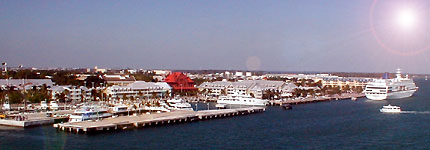|
City Community
Accommodation
Associations
Bars
Beaches
Clubs
Dining Out
Excursions
Gyms
Saunas
Shops
Tourist Information
Tours
 Download Maps Download Maps
 Download Movies Download Movies



|


Key West's long and colorful past begins...
...with its European discovery in 1513 by Ponce de Leon. The island was first known as Cayo Hueso (Isle of Bones) because it was littered with remains from an Indian battlefield or burial ground. The name "Key West" is the English version of the Spanish term. The first permanent occupancy in the City occurred in 1822, complete with a small naval depot, whose purpose was to rid the area of pirates. The presence of the U.S. Navy has been a major factor in the growth and development of Key West ever since. The settlement was incorporated in 1828, four years after becoming the county seat of Monroe County. The City grew and prospered, based first on fishing and salvaging ships wrecked on the nearby reefs, and later on cigar manufacturing with Cuban refugees and imported Cuban tobacco. Other economic activities included sponging and related commercial functions. By 1890, Key West was the largest and richest city in Florida. However, after the turn of the century its major industries were in decline. Little construction was undertaken between the First and Second World Wars and the City saw a steady decline in population between 1919 and 1935.
World War II brought prosperity back to Key West. Population more than doubled between 1940 and 1960. Nation-wide military base closings and personnel reductions beginning in the 1960s were major contributors to the City's second major cycle of population decline. After recording the highest number of residents in its history in 1960, Key West experienced over a 25 percent loss in population by 1980. The 1990 Census showed a slight increase.
Tthere are large numbers of buildings in the community that are near or over a century old. The historical structures of Key West are not grand public facilities, as churches and government buildings, but are homes and cottages-still in private ownership-built by persons without formal architectural training. These historical buildings are found in a 190 block ( 919 acre) area in the western end of the City. Within the historical area are 2,580 structures containing the greatest cluster of wooden buildings in Florida and one of the largest concentrations in the U.S. Generally, the structures date from 1886 to 1912, but they represent the building tradition of Key West from 1838.
The city's historical area, known as "Old Town", has a very distinctive appearance, combining features of both New England and Bahamian building styles. The basic features which distinguish the local architecture includes wood frame construction of one to two-and-a-half story structures set on foundation piers about three feet above the ground. Exterior characteristics of the buildings are peaked "tin" roofs, horizontal wood siding, pastel shades of paint, side-hinged louvered shutters, covered porches (or balconies, galleries, or verandas) along the fronts of the structures, and wood lattice screens covering the area elevated by the piers. A small but striking characteristic is the wooden balustrade and other ornamental trim present around the porches. The neighborhoods in which these buildings are located have their own distinctive features. These include a grid street pattern, buildings set close to each other and to the street, a diverse mix of building sizes and heights, fences of wood picket or wrought iron or low masonry walls, and dozens of alleys or lanes, with their own cluster of dwellings, entering the local street system at irregular intervals.
Key West had a 1990 population of 24,832 year-around inhabitants. This was a slight increase (450 persons) since 1980. In addition to the permanent residents, the City was also home to an estimated 12,887 more seasonal visitors, including 1,628 living in the community three to five months per year, and 11,259 staying less than three months. This meant that on an average day the number of persons in Key West swelled to 37,539. By 1999, the City had an estimated permanent population of 27,698 in addition to 18,630 tourist/visitors, for a total daily population of just over 46,000.
Characteristics of the population are available only on the permanent residents as of 1990. The median age of the local citizens was 33.7 years, in contrast to the Florida average of 36.5 years. About 7 percent of the City's population was of pre-school age (0 to 5), 13 percent of school age (5 to 18), 68 percent of working age (18 to 65), and 12 percent of retirement age (65 and above). The age groupings of the local residents have changed very little between 1980 and 1990. Of the full-time residents, 72 percent were white (non-Hispanic), 10 percent were black (non-Hispanic), less than one percent were of all other races (non-Hispanic), and 16 percent were of Hispanic origin (of any race). Key West also has a large and diverse gay and lesbian population. One characteristic of the local population is great mobility. Almost two-thirds of the 1990 inhabitants didn't live in the same dwelling five years previously, and only an estimated 20 percent of residents lived in the same dwelling over 15 years.
|
